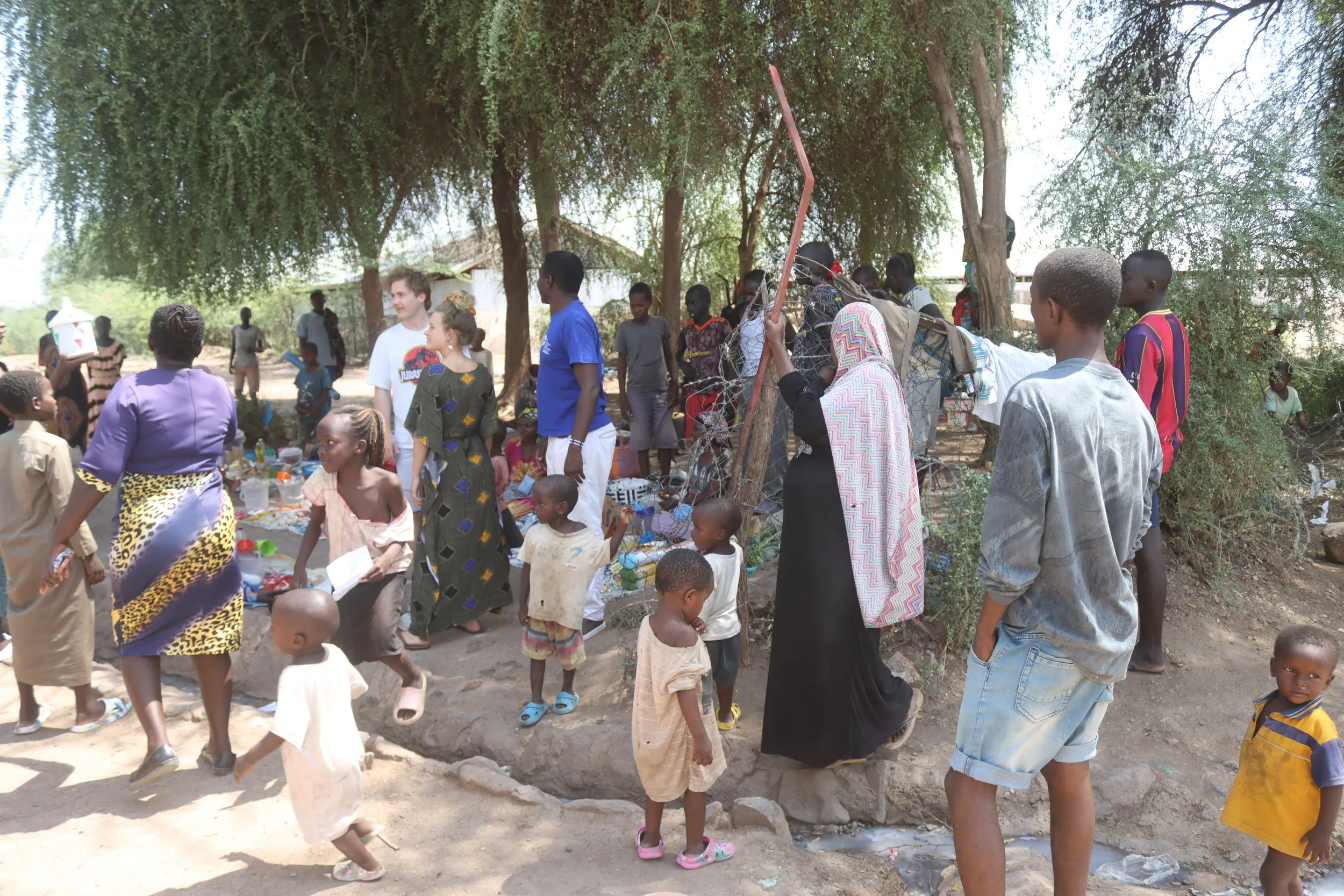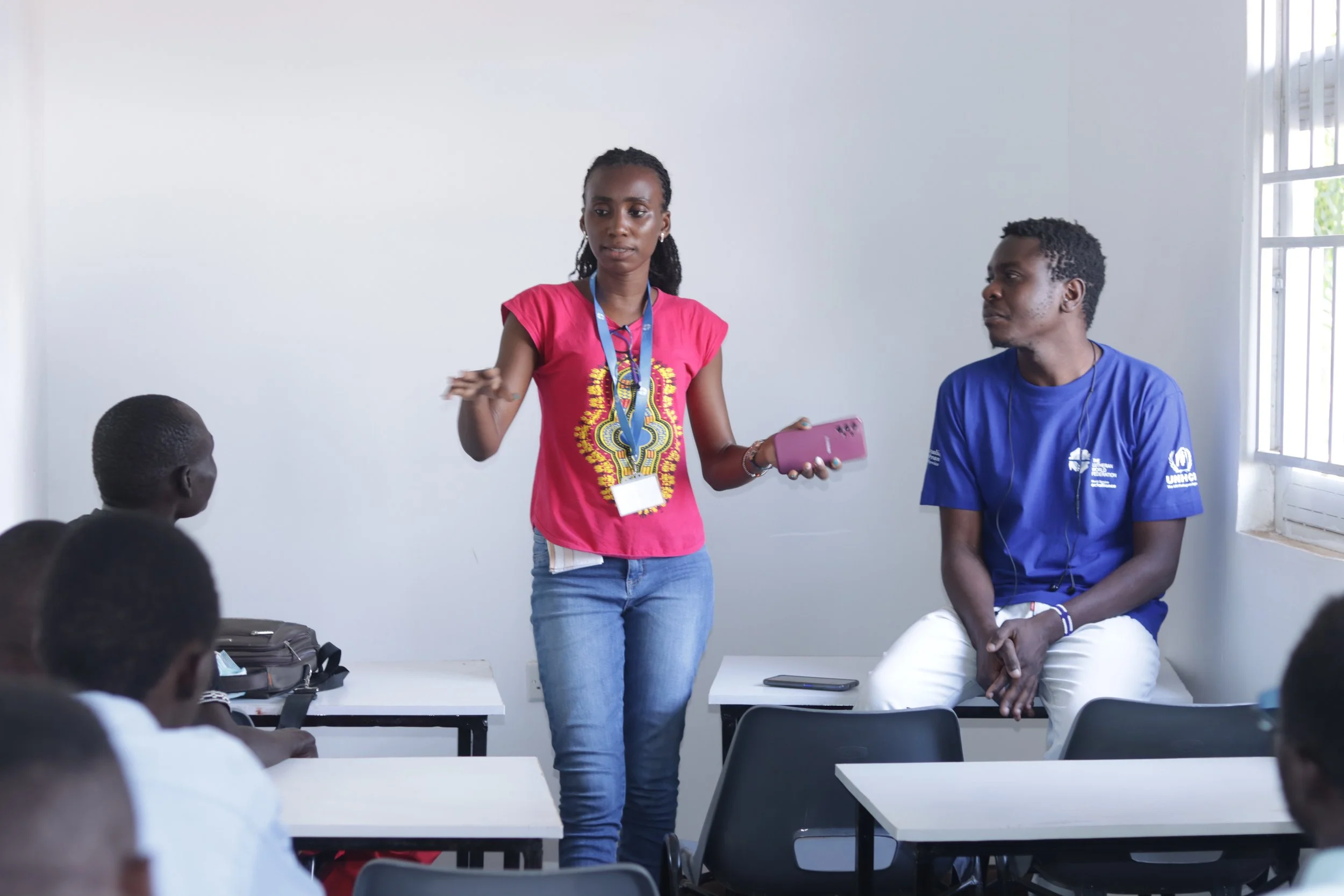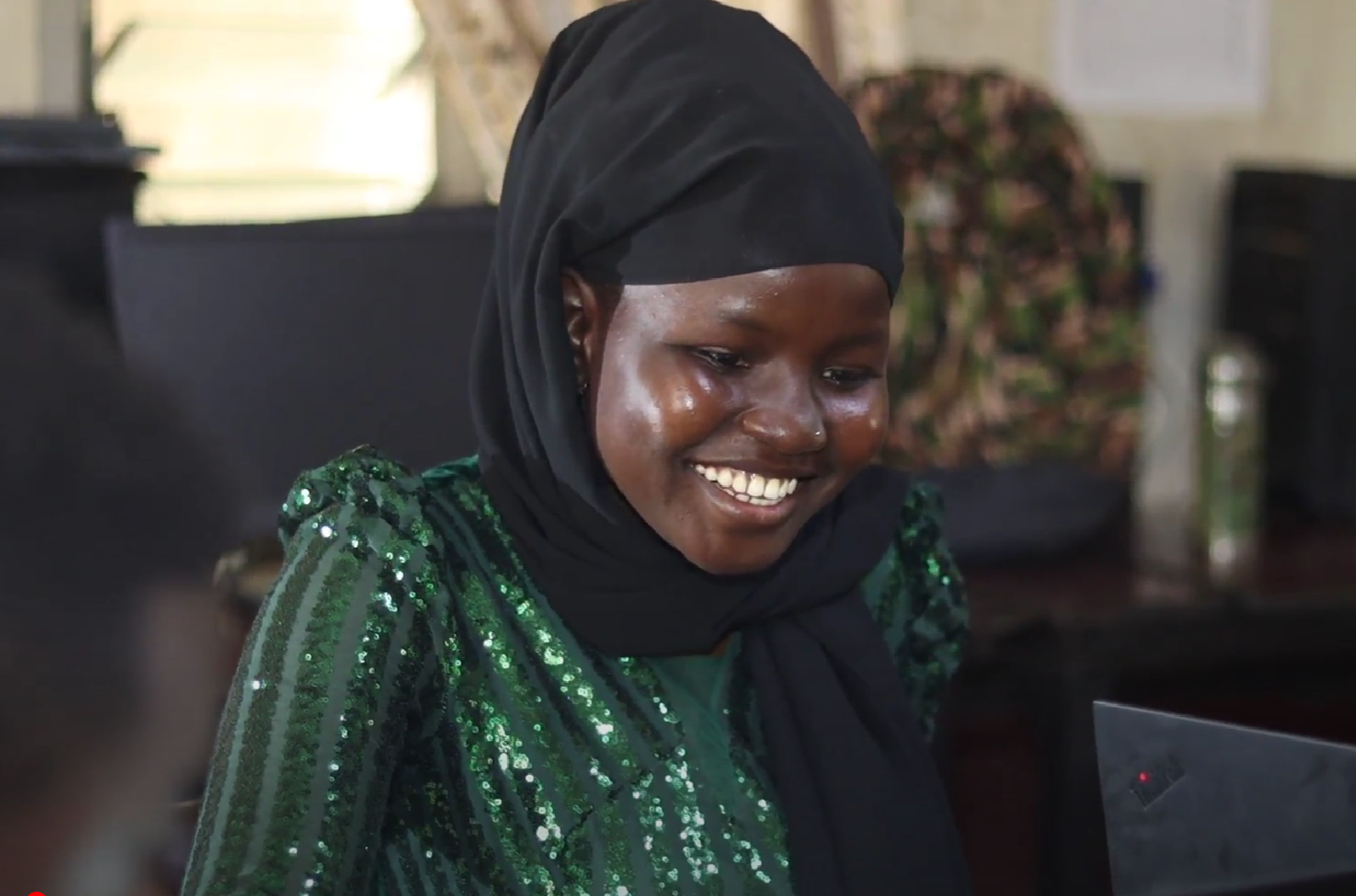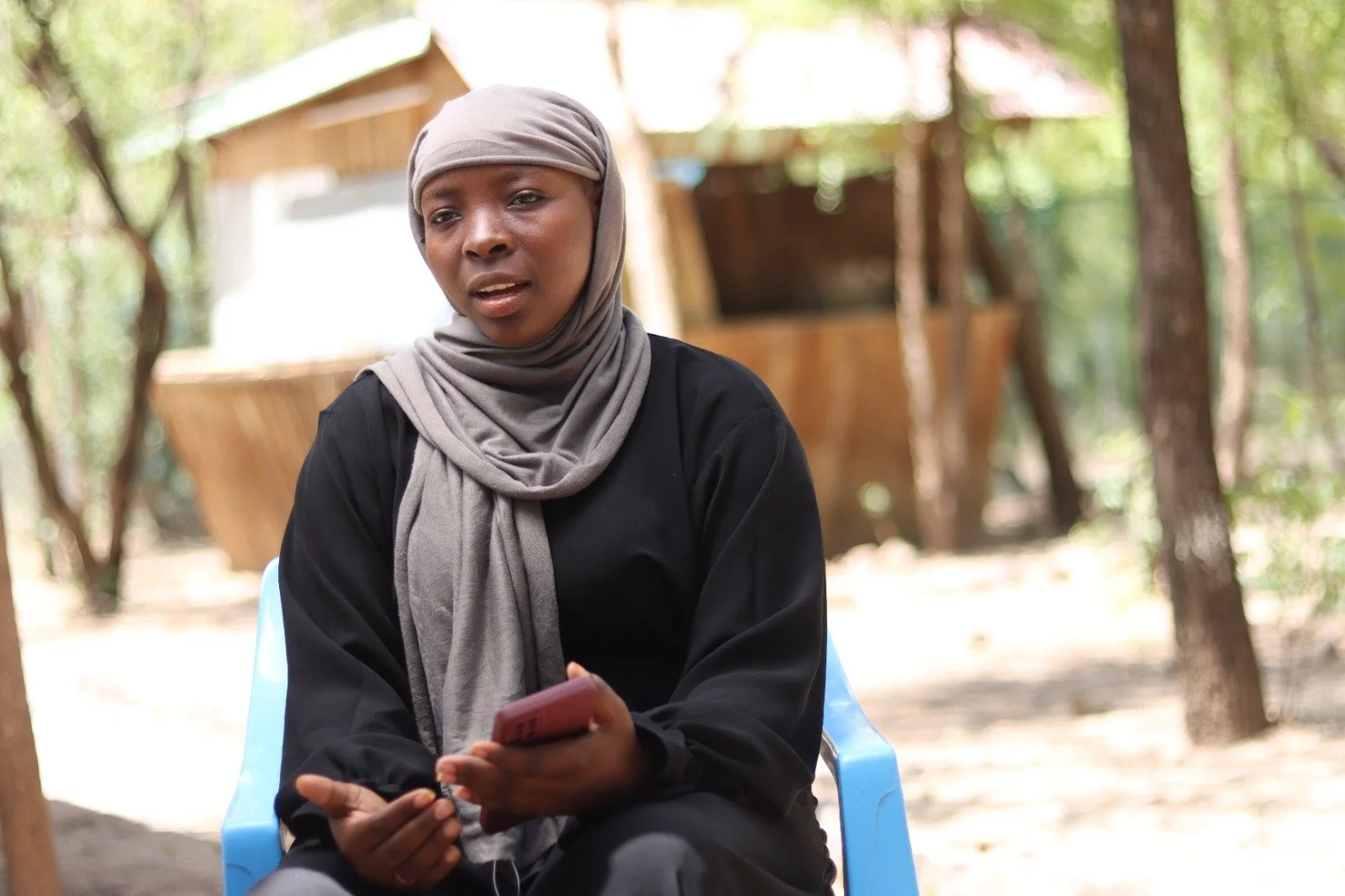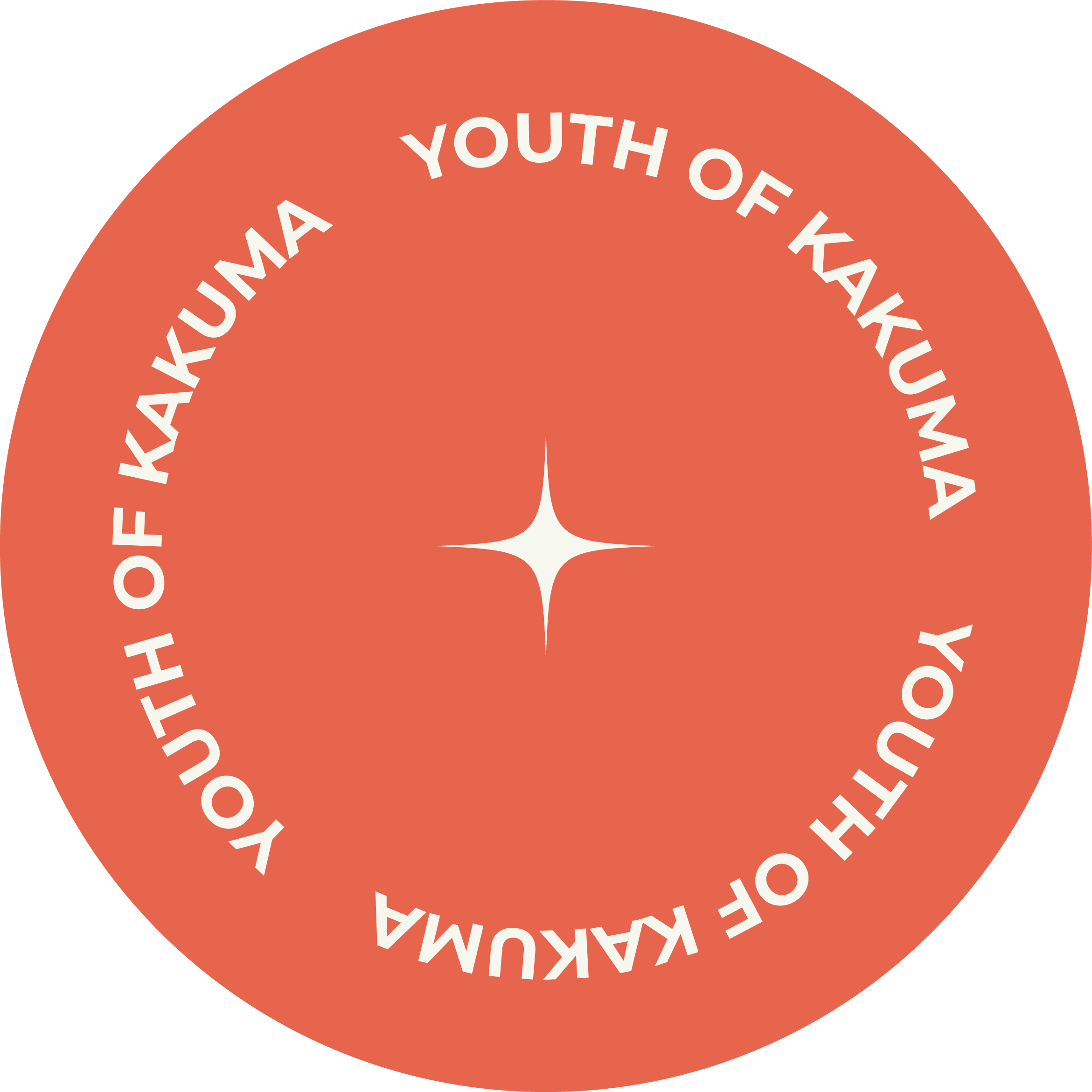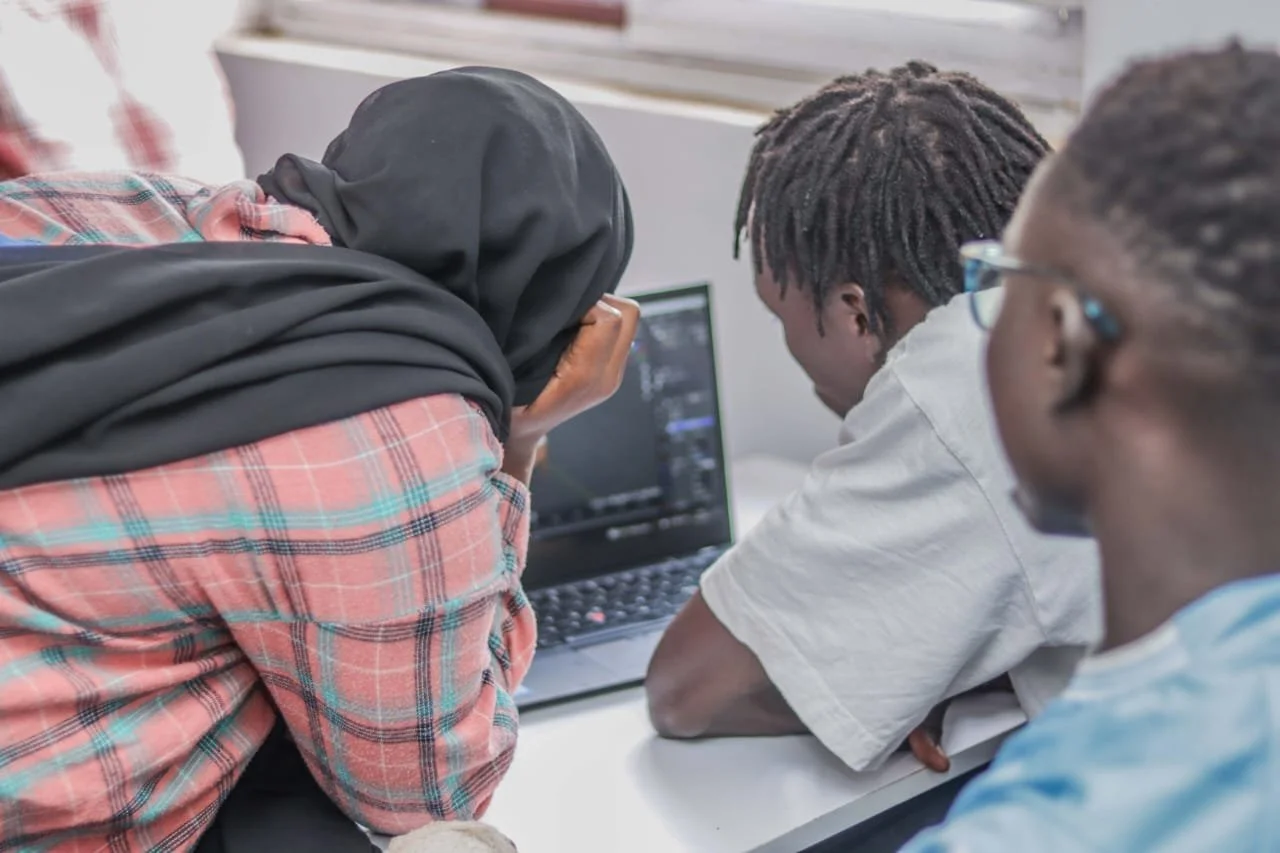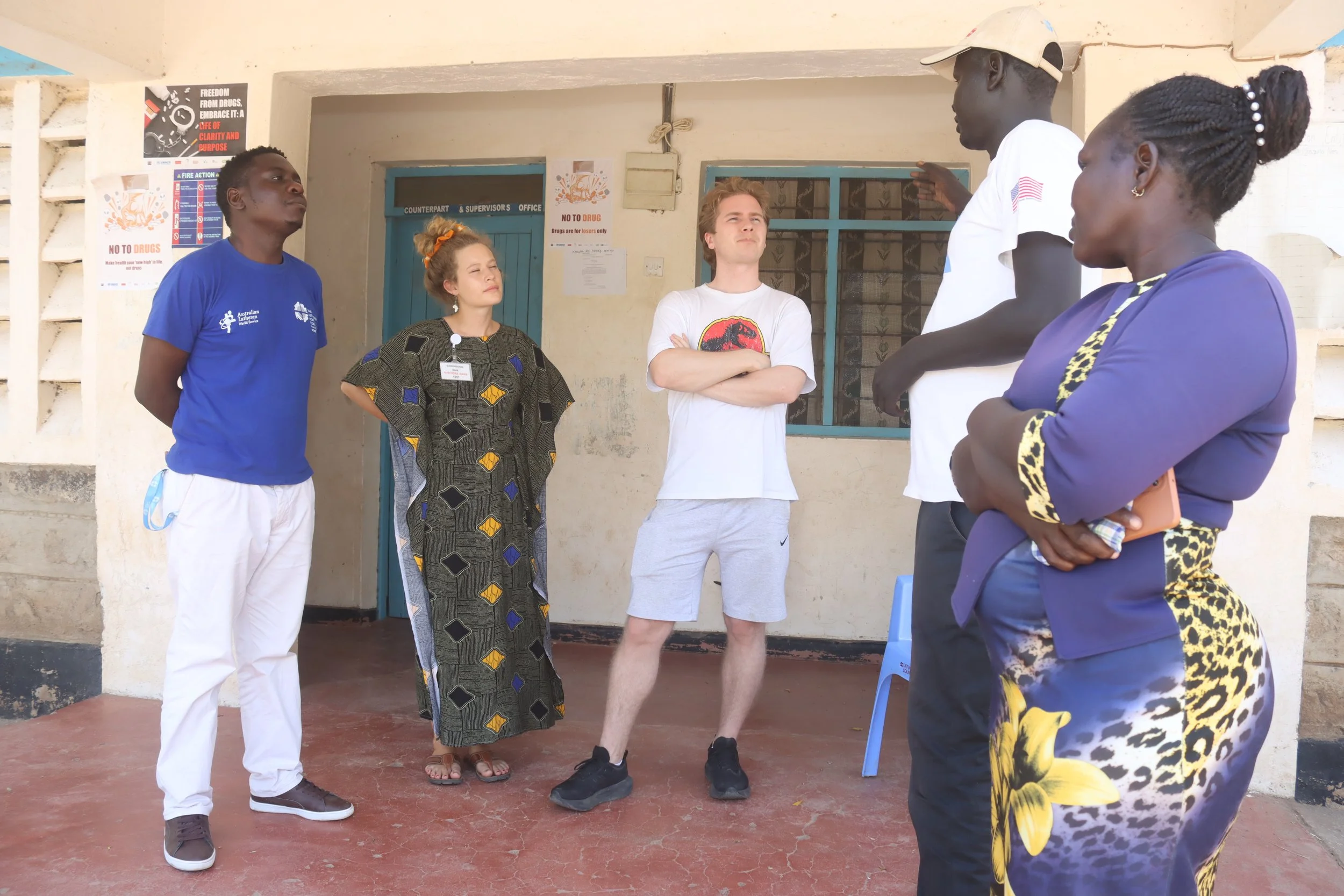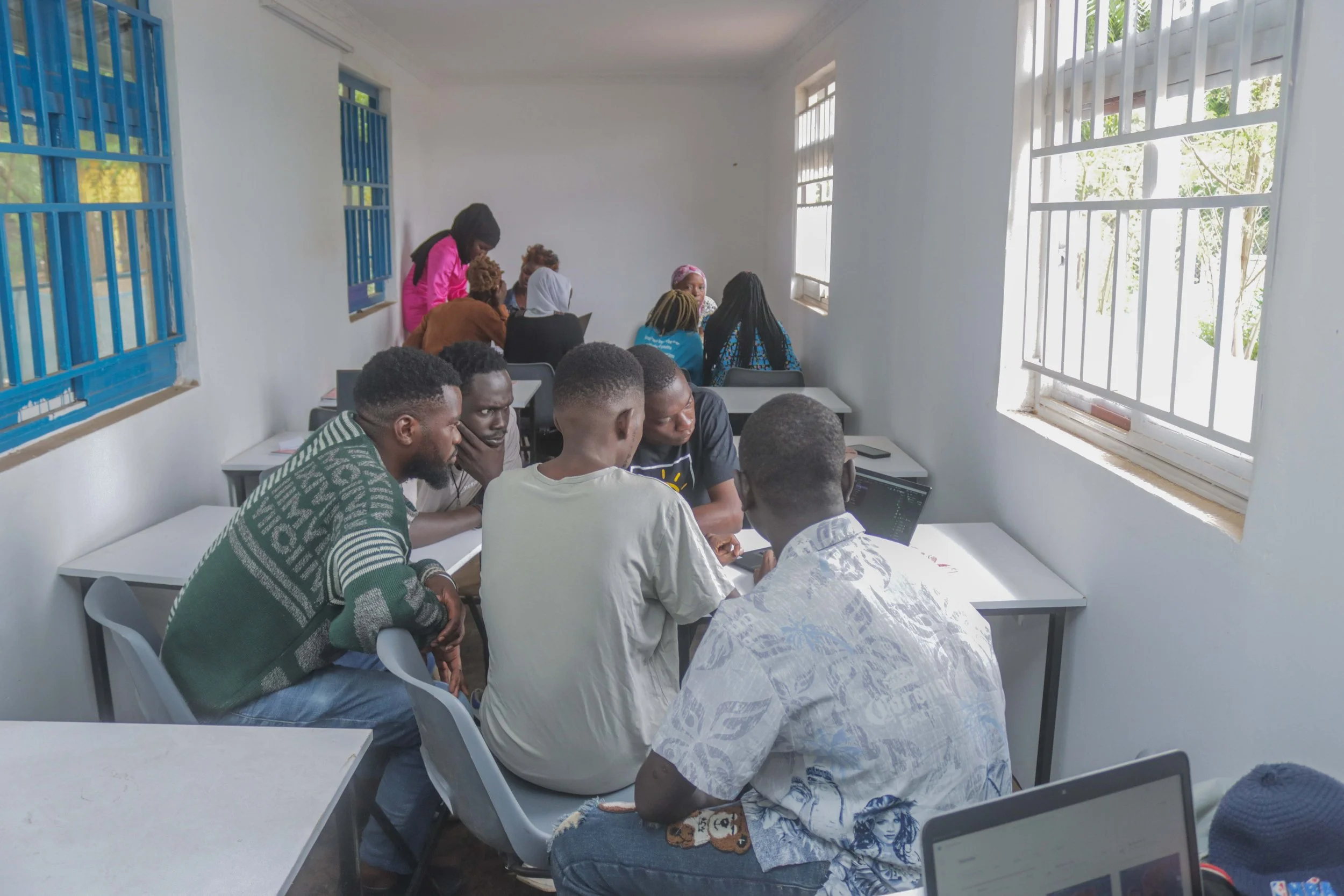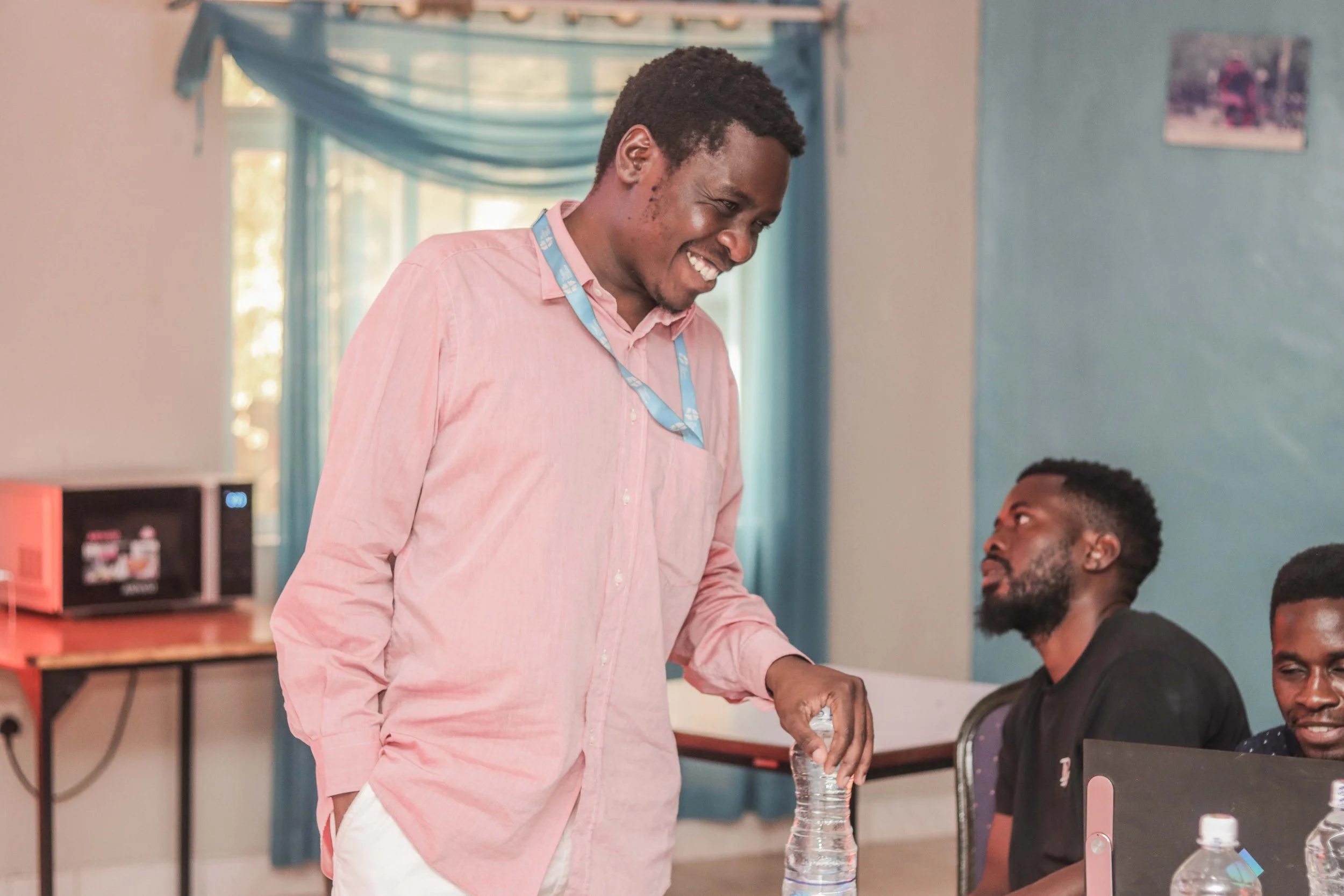What has the pilot taught us?
The Pilot Assessment of the Creative Gateway project highlights the scope of the project, and the journey and progress made during the first nine months of implementation in Kakuma, Kenya. Focusing on the learning, early results, and key takeaways from the first two cohorts, the report tracks the growth of three students as they navigate this innovative program.
What makes this project model the “first of its kind”?
What goals has the project set, and what do the initial results suggest about its impact on the youth of Kakuma?
We invite you to read the full-length report or watch the 8-minute video summary by clicking the links below
INTRODUCTION
This is the pilot assessment of Ambitious Africa’s livelihood project Creative Kakuma in the refugee settlement in Turkana County, Kenya. This rapport introduces you to the project and what has been taking place on-site in Kakuma during the first seven months of the project’s implementation, from October 2023 to May 2024. The young participants will offer you a glimpse into their lives in Kakuma, and the circumstances they live in. This rapport aims to answer the following questions: Why did Ambitious Africa decide to go to Kakuma? What does the project’s model look like? In what ways is a project like this relevant in this context? What is the goal of the project, and what does Ambitious Africa hope to achieve in terms of impact on the lives of the participants?
The insights for this assessment were garnered through observation, interviews, and interactions with participants and different community members in the Kakuma refugee camp to help the Creative Kakuma team analyse and further develop their project. It should be noted that many of the insights presented in this report are based on anecdotal evidence; the conclusions drawn at this point should be understood as speculative, providing a first glimpse into the project’s possible future implications for its beneficiaries.
1
In the first section of this report, you will receive a general overview of the project and be introduced to the youth of Kakuma.
2
The second section delves into our findings so far, highlighting key takeaways, challenges, and opportunities. It also outlines how the Creative Kakuma project team plans to address these issues going forward.
KAKUMA
KENYA
280.000 + REFUGEES
UNEMPLOYMENT RATE OVER 80%
UNDER 18 YEARS OLD
DEMOGRAPHIC
54,4%
OVER 18 YEARS OLD
45,6%
MAIN OBSTACLES FOR SETTING UP A BUSINESS IN KAKUMA
Lack of necessary equipment
Lack of adequate skills training
Lack of office space
Difficulty accessing market
Difficulty acquiring business license as a refugee
CHALLENGING CIRCUMSTANCES
In the following part we will explore what kind of reality the refugees live in, what the purpose of the Creative Gateway project is, and how is it relevant in this setting.
The Kakuma-Kalobeyei integrated settlement in north-western Kenya houses more than 280.000 refugees and asylum seekers from countries including Somalia, South Sudan, DRC, Ethiopia, Sudan, Burundi, and Uganda.
It is a place where many different cultures, customs, traditions, and religions come together, willingly and unwillingly, having been forced to flee their home countries due to war and conflict.
The unfortunate reality is that most refugees in Kakuma live in protracted displacement, meaning several generations of families have lived most of their lives in the camp.
The camp was established in the early 90s amid the semi-nomadic, pastoral Kenyan communities living in the area (hereafter host community) who have since had to give up much of their land to accommodate the ever-growing number of refugees in the rapidly growing camp. Although the population in the refugee camp has fluctuated through the years, it has increased dramatically from a few thousand in the first half of the '90s, to around 80.000 in 2008, and 200.000 in 2020. Four years later, as of 31 March 2024, the population stood at just over 280.000.
The ultimate goal for Ambitious Africa is to create the blueprint of a model for enabling youth to efficiently secure their livelihoods that can be applied to any refugee setting and settlement, not only in Kenya.
Through the combined effort of the Government of Kenya, the UN Refugee Agency (UNHCR), and other humanitarian and development organisations, basic services like health care, education, water and sanitation, food, shelter, and financial aid are delivered to Kakuma. The population grows every week, and so too does the concern that the current funds and capacities won’t be able to secure these services to refugees and hosts in the future.
Self-employment is a viable way for youth to secure their livelihood. There are, however, certain challenges and obstacles that make it hard for them to realise their potential. Among the most frequently reported hurdles are lack of necessary equipment, adequate skills training, office space, and access to the global market. Further, acquiring a Refugee Identity Document, which is necessary to open up a bank account or to apply for a work permit and business licence, has been shown to be a very time-consuming process which complicates matters even more.
Up until Kenya’s Refugee Act 2021, refugees had restricted freedom of movement and were hardly integrated into Kenyan society. With the Refugee Act, the Kenyan government and the UNHCR plan to enhance the economic and social inclusion of refugees living in Kenya. Refugees should not only “survive”, but be able to contribute to the local and national economy and build a future for themselves. Time is yet to tell how the implementation of the act will unfold.
More than half (54,4%) of the population in Kakuma are under 18-years-old. An overwhelming majority of youth and up to 35-year-olds are unemployed. The number of people vastly outnumbers the available job opportunities. These circumstances put most youth in a state of limbo, where they have no option but to think only short-term: Where do my family and I get our next meal? How can we afford to pay our bills on Thursday? How will we be able to save a little extra money for medication and emergencies? An activity almost everyone engages in, regardless of age, is what is colloquially called "hustling". Hustling entails any activity that will earn you some money, enough to hopefully satisfy your basic needs and those of the closest to you. Hustling can mean becoming a moped taxi driver, working as a mechanic, or selling hard-boiled eggs in town.
For most, being able to make long-term plans to ensure the security and stability of themselves and their families is a luxury they can only dream of. This is why Ambitious Africa created the Creative Gateway initiative. By aligning the interests of Kakuma’s youth with the global market demands, and by adding the industry knowledge, skills, and resources of the Nordic private sector, the mission of the project is to create an effective and viable avenue for all youth to earn their livelihood from within refugee settlements.
The Creative Kakuma initiative is the first of its kind, and if the model can produce the desired outcomes, the idea is to bring it to other settlements in Kenya and neighbouring countries in the near future. As a small, independent NGO operating hand-in-hand with the private sector, Ambitious Africa is uniquely well-equipped to respond and react to the dynamic and uncertain environment of a refugee settlement.
PEOPLE CENTERED DEVELOPMENT
What has Ambitious Africa set out to do, how will they do it, and what do they hope to accomplish?
Digital skills upskilling programmes and freelance training have been tried and tested before in many countries, as well as in low-income communities, including Kakuma. Most of these types of training have unfortunately neither had any connection to the market and its demands nor equipped its participants with relevant marketable skills. The participants have been rewarded with a diploma, but that has been the end of it. People have been left to their own devices, wondering what to do next. In Kakuma, e.g., these trainings have been too closely tied to the local setting, which does not necessarily translate well to a global setting or the demands of clients in high-income countries.
Ambitious Africa is deploying a leapfrog strategy that has not been attempted before. The basic premise is that if the market in Kakuma is not able to provide youth with the jobs and opportunities they desperately need, this project will bring the market to them. Rather than guessing what skills are in high demand on the global market Ambitious Africa has asked companies to share what they are looking for, and what skills they want to outsource. These needs have then been aligned with the interests and aspirations of the youth in Kakuma. If the youth can’t conduct business locally, this program will connect them with companies from overseas. The result of this equation is the skills development program Creative Kakuma.
The alignment of the market demands and the interests of the youth has resulted in a six-week course in 3D modelling. This is a craft that is highly relevant in today’s world in many different lines of industry, such as extended reality, gaming, and product development. It also applies well to the refugee setting since it can be done online from anywhere.
The Creative Kakuma initiative lays the foundation for participants to secure their livelihoods by providing essential resources, establishing vital infrastructure, and delivering the skills training necessary for becoming an online freelancer. The goal is to prepare and teach the youth to become self-reliant professionals. The participants will be directly connected with future employers as the project’s partner companies will employ the participants on a project basis, offering them one of their first real and paid 3D modelling jobs. Initially, the project will also examine the suitability of the online freelancing platforms Fiverr and Upwork to connect the participants with clients. This is a way to kickstart their careers and help them build their portfolios. Other options and additional avenues are continuously being tested and reviewed.
The economic participation and inclusion of refugees in markets that are beyond the reach of the camp has been a topic over the past twenty years. The consensus is that this may be a viable pathway to reduce poverty, ensure the inherent right of all to a dignified life, and enable refugees to achieve self-reliance. Sadly, the scale and reach of initiatives that pledge and promote such inclusion have been limited, in many cases due to the structural and legal barriers mentioned earlier. The persistent inability to provide sustainable economic opportunities for refugees often results in continued dependence on humanitarian aid, straining donor resources and patience. “Donor fatigue” is not unheard of.
The change agents bring with them new knowledge, skills, and above all hope to those around them. Ambitious Africa does not believe it can single-handedly change the lives of the youth in Kakuma, but rather wish to empower the youth to do it themselves. This is one of the cornerstones of Ambitious Africa’s mission - to act as support and facilitators while the great people of Kakuma maintain ownership.
“This course is not meant to be for the masses, but rather to cultivate agents of change who will act as role models, proponents of change, and influencers in their respective communities.”
Encouragingly, although the figures remain low, the trend has been positive in recent years. Closer collaboration between the third- and private sectors has been called for, something that ACT Church of Sweden, e.g., has been a proponent of for many years now. The Mega Pledge, led by the Refugee Self-Reliance Initiative and UNHCR, through which a wide range of stakeholders are called to make concrete commitments to advance the self-reliance of refugees, other forcibly displaced and stateless people, and host communities is another exciting new initiative.
Creative Gateway is Ambitious Africa’s attempt to breathe new life into this issue and contribute to this positive trend by setting a benchmark for other smaller actors.
THE CREATIVE HUB
In collaboration with the Lutheran World Federation and local contractors, Ambitious Africa has overseen the construction of a digital hub for current and future project participants. This hub, fashioned from a repurposed freight container, offers a secure environment for attending classes, practicing and refining skills, and engaging in collaborative learning.
The approximately 28 m² container, located in Camp 1 in Kakuma, is equipped with all the necessary office amenities and is linked to both the electrical grid and the internet, ensuring a comfortable, air-conditioned workspace with a reliable internet connection for the participants.
The Creative Hub has been up and running since March of 2024. What is left now is purely cosmetic - the outside of the container is to be painted by local youth artists.
With the digital hub, the project aims to address the most common challenges in the camp, namely the lack of a stable internet connection, office space, and equipment.
Watch the project's local lead Cyril explain how the creative hub came to be.
Video from the summer of 2023.
THE TALENTED YOUTH FROM KAKUMA
The people living in and around Kakuma refugee camp are generally divided into two groups: host- and refugee community. The host community refers to Kenyan nationals from Turkana County, the land where the camp was established in the early 90s. The native Kenyan settlements and communities, many of them semi-nomadic still to this day, gave up much of their land to host and accommodate the increasing number of refugees entering Kenya from Ethiopia and Somalia at the time.
Since then, the camp has grown much at the expense of the host community, and today they are as disadvantaged as the refugee community. This is why this project needs to support and include both hosts and refugees, as well as an equal mix of boys and girls, all of which are taken into careful consideration in the selection process for the course.
The participants in Creative Kakuma's two first-ever cohorts come from a wide range of different backgrounds, from both the host- and refugee communities. They range between 19-28 years old, each with their own unique stories, interests, and aspirations. Though all of them have a diploma for having completed a course in computer literacy and practical skills in ICT, one of the selection criteria, none of them had any experience in 3D modelling.
MEET THE YOUNG TALENTS
MEET THE YOUNG TALENTS
WHOE ARE THESE FUTURE AGENTS OF CHANGE?
Let us introduce them to you!
RAHMA NAPEYOK
ZUWENA HUSSEIN
ANDERSON “O.J” EJIKON
WHAT DO YOU DO IN YOUR SPARE TIME?
Rahma plays basketball in a team. Her team does not have a preplanned game schedule to follow, she says, but they train every day to be prepared - a call to a match can come at any time! Quality time with the family is spent in church, or at home dancing to good music.
WHAT ELSE HAS THE COURSE TAUGHT YOU?
Teamwork: in class, they realised they all possessed different skill sets and interests that could be mutually beneficial – and if you put all of them together "you get an awesome skill!"
WORKING ON YOUR FIRST FOUR GIGS, WAS THERE SOMETHING YOU LEARNED THAT HAD NOT COME UP IN CLASS BEFORE?
Clear communication between the designer and client has been emphasised as crucially important throughout her training. Working on her first four gigs, Rahma learned to understand what “clear communication” means in practice. She highlights the importance of ironing out all the small details of the assignment with the client, daring to ask for clarification on things she’s uncertain about, like what the assignment and the design are intended for and precise measurements of the object in question. Rahma exudes confidence, curiosity, and a go-getter mentality. “Things will come up that you realise you are not familiar with”, she says. “You take notes, and you start working. You cannot always turn to your teacher or mentor for advice, you must look for the solutions yourself. The more you search (information on the web), the more you learn”, she continues.
“When you are a learner, you just go ahead (and teach yourself). You don’t have to wait for the teacher to finish everything. The teacher gives you 75%, and theremaining 25% comes from within you.”
IMAGINE IN THE FUTURE, WORKING AS A 3D DESIGNER, YOU WOULD BE ABLE TO SAVE KSH 30.000 ($ 230) PER MONTH. IN ONE YEAR THAT ACCUMULATES TO ALMOST KSH 400.00 ($ 3000) – WHAT WOULD YOU SAVE IT FOR?
“First of all, you can eat three times a day. Second, you could treat yourself and your family: with little money, our breakfast is usually tea and mandazi (deep-fried slightly sweet bread-like dough), but with some extra in our pockets we could have milk, bread, even jam, on the table.”
“Third, with that kind of money I could start investing in rentals. I would construct houses for people to rent on a monthly basis. The rent for one room, kitchen, and bathroom is around ksh 6000. If you have ten of them, that’s already very good money every month”
HUSTLING IN THE PAST
Rahma spent a year (before to applying to Creative Gateway) working in different kiosks in town, selling fruit and vegetables, flour and pastries, sweets and pre-paid phones. Her working hours were between 8 – 17, six days a week, and she earned between 6000 – 7000 KSh (around 50 USD) per month. Being from the host community, her family must pay tuition fees so the children can attend school. Most of the money Rahma earned by hustling she gave to her mother to help pay for her siblings’ school fees. With what was left she could treat herself with a bottle of shampoo, e.g.
Rahma Napeyok
KENYAN
BORN IN KAKUMA
19-YEARS-OLD
A CERTAIN PROFESSION YOU HAVE ALWAYS DREAMED OF?
Since high school, she has dreamt of two professions: to become a teacher or an architect designing houses and living spaces. Creative Kakuma has allowed her to pursue her dream of becoming an architect for real.
Rahma has become a mentor for the participants in the second cohort who enrolled in the 3D course in mid-January 2024. By being present in class and acting as an assistant facilitator for Cyril, she gets to experience first-hand what it may be like to work as a teacher.
“You know, when you are in school, you have two dreams, or three, so that if any one of them comes true you will be ok.”
WHAT COULD FREELANCE WORK MEAN SPECIFICALLY FOR YOUNG WOMEN IN KAKUMA?
Freelancing online exposes women to the outside world, to a reality where women are so much more than simple stay-at-home maids who take care of the house and raise children. Seeing that for themselves first-hand can give them the courage and motivation to start believing that that is a future they could have.
ARE YOUTH EMPLOYED AFTER FINISHING SECONDARY SCHOOL, AND WHAT ARE SOME TYPICAL JOBS?
Job opportunities are very limited in Kakuma. There are simply too many people for all to find employment among the available opportunities. Some organisations offer training and small side jobs here and there, typical examples being primary school teaching and nursing at the hospital. These trainings vary in length from a few days to a couple of weeks, some pay and some don't. The youth that gets the chance to partake in these trainings come out with new sets of skills, but very few are employed afterwards.
FIRST COMPLETED JOBS
-
Project Manager Vincent's home kitchen
Two weeks to complete
Earned Rahma $25

-
The Creative Hub
Two weeks to complete
$25

-
Replica of a wooden table in the Hub
One week to complete.
$20

-
The Mansion
A task given to Rahma by LWF. She got a picture and was asked to design the exterior and the garden.
It took one week for her to complete the task, and she was paid Ksh 5000 ($ 38) for the job.

TELL US SOMETHING ABOUT YOUR LIVING CONDITIONS?
Neither of her parents has a job. Everyone in the family who can will hustle to provide for the family. The good thing is this means the family spends a lot of time together. Her father often gathers the family and tells them stories about Burundi, their heritage, and their culture, since most of the children are too young to remember.
DO THE DIFFERENT COMMUNITIES IN KAKUMA SPEND TIME TOGETHER?
In some areas of the camp, different communities and nationalities mix – Burundians living together with Sudanese and Congolese. If not together then very close to each other. A common place where different communities often meet and mingle is when they go fetch water at the tap. Thanks to these interactions, you get a Burundian married to a Somali, for instance, cultivating a greater sense of belonging and community. They help each other and are good friends who share stories and gossip. There is a sense of togetherness, Zuwena says.
Zuwena Hussein
BURUNDIAN
CAME TO KAKUMA WUTH HER FAMILY IN 2009
THE FIFHT CHILD IN A FAMILY OF 12 CHILDREN
ENJOYS LISTENING TO R&B
After graduating from high school, she had nothing to do and was actively on the lookout for opportunities that could help her achieve her career aspirations and also support her family. Interior design has also been an interest of hers.
She saw the Creative Kakuma course as a fantastic opportunity to realise her dreams. For one, she might earn a pretty penny after the course, which would help her family a lot. She also saw the connection between interior design and 3D modelling.
The biggest motivator is her family - especially her mother, who has supported her ever since she first applied to the course. Her mother has followed her progress every day and encouraged her to carry on in times of doubt and difficulty.
“When I get a job and earn income, I want to open up a shop for my mother so that she can do her business... we contribute together to satisfy the needs of our family.”
Her inexperience and her being quite nervous working on her first real, paid job made her momentarily doubt her abilities. By the end, she had requested three (3) feedback sessions to address the challenges she faced. She must deal with issues and doubts that arise more effectively in the future to avoid excessive back-and-forth communication with the client. Luckily, Isac from StudioExakt was easy to work with and extremely supportive, and the assignment turned out to be a great learning experience for Zuwena.
“When I have satisfied my own immediate needs and those of my family, with what I have left I’d help others in my community, orphans for example. Also, if there is still money remaining, I’ll take myself to university.”
“So, I just want for now to work hard so that when the time comes for me to start my own family and have my own kids, they will be able to get anything they need. They will not struggle the way I struggled. “
WHAT WERE THE MOST IMPORTANT LESSONS AND TAKE-AWAYS SHE LEARNED WORKING WITH HER FIRST REAL CLIENT, STUDIO EXAKT?
Zuwena mentions two things that stand out. First, up until then she was used to working with clear reference images with clear details and textures. The model StudioExakt asked Zuwena to make a 3D model of was given to her as a 2D drawing. Visualising what the model would look like by combining the drawings from different angles was a completely novel challenge for her and took a few iterations and consultations with Isac from StudioExakt to solve. Secondly, like Rahma, she got to realise the importance of clear communication between client and freelancer. “Unless you clearly understand the assignment, and what your client wants, you will not be able to deliver anything of value. To do that, you must dare to ask questions when in doubt”, Zuwena says.
HUSTLING IN THE PAST
Zuwena worked for almost a year as an assistant at a hair salon, seven days a week, ten-to-twelve-hour shifts. Half of the money she earned went to the salon. She averaged between ksh 100 – 300 ($ 0,70 – 2,30) per day. The money she earned from her hustling allowed her to buy vegetables and fruit on her way home from work so that she and her family could get a more varied diet.
WHY DID YOU APPLY TO THE CREATIVE KAKUMA PROJECT?
WHAT MOTIVATES YOU TO PURSUE YOUR FUTURE GOALS AND VISIONS?
IMAGINE NOW FOR A MOMENT, A YEAR OR TWO FROM NOW, YOU EARN 140.00 KSh (1k USD) PER MONTH WORKING AS A FREELANCER (MORE THAN HOTEL AND RESTAURANT PERSONNEL EARN IN A YEAR) – WHAT DOES YOUR EVERYDAY LOOK LIKE?
With such an income, she can start realising many of her dreams: opening the shop for her mother, having food on the table every day of the month, and paying her sibling’s school fees, e.g. For a person who has spent the majority of their life struggling, Zuwena continues, reaching financial security is already life-changing simply because you can get the things in your everyday life that you were always deprived of.
ZUWENAS FIRST COMPLETED JOBS
Zuwena got her first job, the chair seen below, from the project manager Vincent back in November of 2023. It was the most detailed model she had seen at the time. The task was somewhat out of her comfort zone and took some time to figure out, which according to her, was why it took a long time for her to finish. The level of detail in the reference image made for quite complex texturing and rendering. It was a great learning experience, she says, happy with what she accomplished in the end.
FIRST COMPLETED JOBS
-
Assignment from Studio Exakt
Took two weeks to complete.
Zuwena earned $200 from the job.
-
Studio Exakt

-
Photorealistic chair
Assignment from Vincent. Took three weeks to complete.
Zuwena earned $25 from the job.
WHAT EMPLOYMENT OPPORTUNITIES ARE AVAILABLE TO THE YOUTH IN KAKUMA?
Various organisations occasionally offer side jobs or project-based tasks to the youth, but the competition is fierce. These jobs typically last from a few days to a month, making stable long-term employment nearly impossible to find.
HOW DOES THE LACK OF STABLE LONG-TERM EMPLOYMENT AFFECT THE YOUTH IN KAKUMA?
“So, everyday when you wake up you have to battle with the idea of finding a way to feed yourself and your family. You must do something so you place your bet on anything. You have looked everywhere for a job, but you find none. The desperation that follows forces people to do bad stuff.”
“Everyone dreams about the future, in different ways. They want to pursue something, a job perhaps, or a career. Maybe tomorrow is my day. Tomorrow comes and they are still in the same situation. Make that happen to someone over and over again and they loose all hope. Why even bother, it’s never going to happen.”
Anderson “O.J” Ejikon
KENYAN
FROM LODWAR (TURKANA) WHERE HIS FAMILY STILL LIVES
28-YEARS-OLD, PROUD FATHER
EARNED HOS BACHELOR’S DEGREE FROM ST. PAUL’S UNIVERSITY IN NAIROBI
WHY, IN YOUR OPINION ARE ENTREPRENEURSHIP AND FREELANCING GOOD WAYS TO SUPPORT YOUTH IN KAKUMA?
Projects like Creative Kakuma give youth a sense of meaning, if not on a deeper level, then at least to do every day – it activates them. It also shows them what a productive everyday life looks like and gives them a sense of purpose and something to work towards.
Anderson often mentions his desire to give back to his community, sharing his fortunes and what he has learned with others. By adding new knowledge and skills to his arsenal, in this instance 3D-modelling, he can further support his peers by passing on these skills so others can take part in them as well. And if not teach others what he has learned, he can at least motivate them to go forward and carry on by being someone who's walked the walk.
ANDERSON SAYS IT TOOK A LONG TIME FOR HIM TO COMPLETE HIS FIRST TWO GIGS - WHY WAS THAT?
The demands and responsibilities of Anderson’s daily life are significant. As a father and husband, he must always be available to tend to his family. Anderson is the sole provider for his household, responsible for ensuring food on the table every day, taking his son to school, and acquiring necessities for the house. These duties consume much of his time. Additionally, he faces a roughly 5-kilometer walk to the Creative Hub from his home. Occasionally, he can borrow his friend’s moped to travel to the container and run errands, but most days he gets around on foot, which takes up a considerable part of his day.
HOW DO YOU SEE THIS COURSE CONTRIBUTING TO YOUR PERSONAL AND PROFESSIONAL DEVELOPMENT?
WILL HE EVER BE ABLE TO COMPLETE FUTURE JOBS FASTER, GIVEN THAT HIS FAMILY DUTIES WILL ALWAYS BE THERE?
He is confident that he will. Anderson continues to improve every day and as his skills increase, he will be more comfortable tackling any challenge and completing them faster. Moreover, once he starts earning a more stable income through freelancing, he can quit his other side job hustles. In April of 2024, his income as a 3D designer was still too small to rely on, so he must still do other work to make ends meet. Working full-time as a freelancer will free up much of his time and eventually enable him to pay for his daily commute, e.g. For reference, a roundtrip with a bodaboda moped taxi to the Creative Hub costs Anderson $ 1.50 in total.
WHAT KIND OF AN IMPACT WOULD A MONTHLY INCOME OF 140.000 KSH HAVE ON YOU AND YOUR FAMILY?
A “bright future” for me is a scenario that is about safety: being able to provide for your family, affording education and healthcare, and not having to worry about where your next meal comes from. That kind of money would grant us this. After that is secured, I could buy my own land and build a house instead of renting. I also want to help and support others in my community that are struggling.
HUSTLING IN THE PAST
Anderson ran a cybercafé from August of 2022 through March of 2023. This earned him between ksh 2000 – 4000 ($ 15 - 30) a week. He was open from Monday to Saturday, from morning to late afternoon. Sadly, he had to close the doors permanently after eight months due to his salary not being enough to cover all his expenses. After paying the rent for his house and satisfying the basic needs of his family, he was not able to cover the rent of the café.
FIRST COMPLETED JOBS
-
Löfberg's Coffee Package
Took four weeks to compete.
Anderson earned $20 from the job.
-
Gaming chair
Took three weeks to complete.
Anderson was paid $25.
-

INITIAL RESULTS AND KEY TAKEAWAYS WORKING WITH THE TWO FIRST COHORTS
A WORD ABOUT ATTENDANCE AND DROP-OUTS
When screening the applicants for the program, LWF looked primarily at prior experience working with tech, overall computer skills, and their letters of intent.
Out of the 40 participants from the first and second cohort who enrolled in the course, a total of 11 will soon have graduated.
There are a few reasons why so many dropped out. Some walked away after the first day having realised the course was not what they had imagined. Some applied because they were hoping attending would be a way to secure at least one meal per day. The lack of laptops and stable access to the internet also led to students dropping out.
“Some come here thinking only about the now, the short-term gains. They fail to look ahead, with patience and resilience, for what they can gain in the long-term.”
Unfortunately, one of the biggest challenges that proved to be a great hurdle for most, that the project team had not anticipated, was logistical – some had to drop out because they had issues getting to class and back home every day. The camp is big, its streets and alleys narrow, bumpy, and extremely muddy when it rains, so commuting long distances is very time-consuming, not to mention dangerous. Some buses circle through many parts of the camp, but only a couple of times a day, and some days not at all.
THE TWO MOST IMPORTANT TAKEAWAYS
Our participants taught us a great deal about themselves and shared their views on our project's potential impact on them and their young peers in Kakuma.
Two things stand out
Unemployment poses a significant challenge that causes stress, uncertainty, and worry among the people in Kakuma. Regardless of age, everyone in Kakuma hustles. In many families, both parents are unemployed, so earning money and putting food on the table becomes an activity even the children must participate in. Many are orphaned and live together with others of roughly the same age. In these households, you work with your “brothers” and “sisters” to make ends meet. Some come up with creative ways to generate an income, albeit small.
Most are not, however, presented with such opportunities or able to capitalise on them. Being idle and unemployed and unable to provide for yourself and your family can make people desperate, and this desperation leads many talented young down a path of crime and violence in Kakuma. They should by no means be considered bad people by nature, but rather individuals absent cause or the necessary resources to kickstart the rest of their lives.
Digital skills and creating livelihoods through online freelancing may also hold great promise for empowering women in Kakuma. Women in Africa are often today still burdened by certain cultural expectations that stand in the way of them becoming independent in their own right. They are expected to start a family, raise the kids, and take care of the household in their late teens. Women in the host community are especially disadvantaged and tied down. There, less than 10% ever graduate from secondary school. They are told they shouldn't work, much less get educated. They lose their self-esteem and dare not even dream of becoming someone and something outside of their homes.
01
02
Creative Kakuma offers youth a chance to become meaningfully engaged.
Empowering women in Kakuma.
Putting their skills and interests to good use and helping their community members is wonderful. Machine repairs, software installation, hairdressing, or fetching water for the elderly are examples of activities youth engage in.
The project participants shared some insight into their hustling in our interviews with them. Before enrolling in Creative Gateway, Brian, one of the graduates from the first cohort, did fieldwork for different organisations, gathering data about a range of issues. The length of this survey work ranges between one to four weeks and pays between ksh 200-2000 ($1,50 - 15) a day. Brian acknowledges that he is one of the very few lucky ones who have access to these jobs.
“Women are highly encouraged by all NGO’s and schools to participate... but the cultural restrictions are still holding women down, destroying their self-esteem. Freelancing could help them become independent.”
The youth acknowledge the digital world and freelancing as viable gateways to opportunities beyond the borders of the camp. Online freelancing not only addresses unemployment but can also serve as a much-needed creative outlet for them that can keep them meaningfully engaged. As we've learned, some manage to find odd jobs here and there, but they are only temporary solutions. What is missing is a long-term strategy. What is needed is a solid foundation from which they can start creating their own futures and be the architects of their success and prosperity, in their own unique ways. This is Ambitious Africa’s mission in Kakuma: to establish this foundation.
Something so deeply rooted in culture cannot be changed through Creative Kakuma alone, but Ambitious Africa may help bring about the change that many other organisations in Kakuma work towards. The local and international development and aid organisations in Kakuma have done invaluable work for many years to include and empower women and girls. Creating lasting cultural change is a long process, but Creative Kakuma can certainly help facilitate such a transformation.
PROMISING UNEXPECTED IMPLICATIONS FOR THE FUTURE
Two other matters were raised by all our graduates independently from one another that we definitely will look into further and take into consideration going forward.
Thanks to the honesty, bravery, and hospitality of the project’s participants, we have been privileged to dive deep into the heart of Kakuma. Sitting opposite these people and listening to their stories makes you forget you’re conducting a pilot assessment or an interview. As someone from an entirely different part of the world, you’re dragged into a reality that is so different from yours and so foreign to you, and begin to understand what those eyes have seen and what lies behind the sometimes stern, sometimes expressionless, faces. Their body language tells you they are comfortable in their own space, unapologetically simply being themselves.
A natural line of thought for all graduates is how they could share what they learn with those around them, and they consistently highlight familial and communal bonds as their primary motivators for pursuing their individual goals and dreams. Zuwena, whom you met earlier in this report, said one of her biggest wishes is to gather enough funds to open a shop for her mother so that she could sell her handicrafts. Another said they wanted to pass on what they've learned to their siblings.
It is no easy task for any young person to find their way through life. Everything starts from within each individual, but it requires community-wide engagement and acceptance to create the avenue and foundation for all youth in Kakuma to make their livelihoods online. The word must spread throughout the different communities, and bringing them closer to each other through cross-community friendships and bonds appears to be a great first step. Beyond sporadic cultural and sporting events or run-ins by the well, the diverse communities and nationalities don't interact much.
01
02
The apparent collective nature of their respective cultures - agents of change by nature.
The promising indication that the project may help bring the different communities closer together.
A smile is never far away, though. The recollection of a fond memory, the sense of pride in something a sibling accomplished, a word of encouragement, or a bad joke will brighten up their faces regularly. Their enthusiasm and determination become clearly visible talking about their hopes and dreams for the future. For them, the future is a scenario that never only includes the self, but also the family, friends, and peers. Engaging with these young individuals reveals the collective nature of the culture they live in, where the needs of the group take precedence over those of the individual, regardless of background, nationality, and religion.
All of them talk about how participating in this project and the skills they learn gives them a chance to give back to their communities, be it through teaching, monetary support, or engaging their peers in the digital world. This is a promising indication that they don’t have to be taught how to become catalysts of positive change in their respective communities - they are agents of change by nature.
“The main reasons why I applied were to improve my own life, the life of other youth, and my community as well.”
One of the things the graduates have enjoyed the most about the project has been finding common ground and similarities among each other. Different communities and backgrounds coming together as they did in the classroom was a new experience for many of them as they developed a new understanding and appreciation for those they share the camp with. The impact of a greater sense of unity among the communities within the camp on engaging and empowering the youth is certainly a topic Ambitious Africa will look into in 2024.
The youth and the communities in Kakuma now have great expectations about Creative Kakuma and Ambitious Africa have many promises to live up to. Rahma's mother shedding a tear and thanking the local lead Cyril from the bottom of her heart because her daughter received her first payment through the project is a testament to the fact that words have become action. Now it is time to make that a reality for so many more.
A WORD FROM THE AUTHOR
ALEXANDER
KURTÉN
Project Evaluation and Communication
M.Sc. Service Management
The month I’ve spent in Kakuma has allowed me to gain some understanding of life in the camp and the realities faced by the people there. While you can only expect to scratch the surface in such a short time, it has provided a solid foundation.
For the past nine months, I’ve immersed myself wholeheartedly in Creative Gateway to provide the project team with an impartial assessment of the development and current trajectory of the project.
Personally, I take a special interest in people, and so my approach from the start has been to understand the subjective reality of the beneficiaries and the different stakeholders of the project. I’ve worked closely with the participants and the project team, and even though most of it has been remote and online, the openness and honesty of all have been invaluable in forming a clear picture of the project’s current state and identifying critical issues that need attention.
Communication and managing expectations
Loose promises
There have been open discussions about providing the participants with, e.g., monetary support for their daily commutes, lunch and refreshments at the hub, and fibre for a more stable internet connection in the container. For reasons that are sometimes out of Ambitious Africa’s control, the project has not been able to fulfil these promises, which has led to growing frustration among the participants, negatively affecting their motivation and the overall atmosphere at the creative hub.
1
2
3
Information relay
Failing to manage expectations has undoubtedly been the leading cause of dropouts so far. It has not been communicated clearly to the participants what this program is all about, what it consists of, what it requires, and what the long-term goal is. As mentioned earlier, some have applied to the course with expectations of a “free lunch”, both literally and figuratively. Food and daily cash hand-outs, e.g., were never meant to be provided in the first place, a matter that was not communicated clearly enough.
What happens after we graduate? Will you just leave us like all the other similar courses?
Solution
The issues of clear, transparent, and honest communication and managing expectations have been a recurring topic of conversation in the Creative Kakuma project team for the past few of months since it was first mentioned. Everyone, me included, is much more aware of the impact our words have on the participants, and constantly work together to improve.
Participant skills development
Technical skills
All participants have made impressive progress, and it’s highly encouraging to see them so hungry to further develop their craft every day. Most have, however, not yet reached a high enough level to take on projects from clients. Many of them underestimate how much they can still learn and improve.
Solution
To allow future clients to assess who among the students would be most suitable for a project they are offering
Currently, Cyril carries the full weight of the responsibility to ensure the daily progress of the project on his shoulders. He is alone in solving the daily tasks and issues of the participants and the project that arise. Welcoming a third cohort will add tremendously to Cyril’s workload, which is already substantial. The project team unanimously agrees that quality will always take precedence over quantity in the Creative Gateway project. Therefore, in April, it was decided to postpone the enrollment of a third cohort with a few months to allow the team enough time to reorganise, recalibrate, and deal with the issues mentioned here.
The project team has discussed some of these issues before, but now I felt it was due time to address them mindfully and carefully, together. These risks, challenges, and opportunities are not necessarily unique to Kakuma, however, it is important you, our reader, keep them in mind when evaluating Creative Gateway.
This was a question I got from a participant from the 2nd cohort two months into their training. They were happy to be reassured that graduating is only the first step in their journey with Ambitious Africa. Communication must be improved.
Soft skills
Becoming a successful online freelancer requires strong interpersonal skills. You must learn how to interact with people from different cultures, negotiate in an online setting, dare to ask questions to make sure you understand the needs of your clients and market yourself on different platforms. More time and effort must be devoted to this topic in the classroom in the future, with current and future participants alike.
The project’s technical lead Jeff is creating a grading system tool that will allow him to grade and evaluate the participants’ work (technical) and performance (soft) more systematically and clearly.
The function of the tool is threefold:
To be a carrot on a stick for the students, motivating them to develop, and helping them visualise and understand where they have the most room for improvement.
To help Jeff and Cyril identify in what areas the participants are struggling individually, which will allow them to provide more personalised and targeted training.
The human factor
Facilitator overload
Solution
The four students from the first cohort who are still actively participating in the project, have been working as assistant facilitators and mentors to the second cohort from the day the new cohort started. Their help and presence in the classroom daily have freed up much of Cyril’s time. Teaching and passing on what they have learned to others has been immensely fun and rewarding for our four assistant facilitators. They will receive a monthly salary for their contribution and will continue working with Cyril for the rest of this year alongside their own freelancing work.
I acknowledge that my exploratory assessment is by no means exhaustive. I would happily share more and discuss the project with anyone interested.
Do not hesitate to reach out
alexander.kurten@gmail.com
+358-405499892
LOOKING AHEAD
Themes Creative Kakuma will focus on for the remainder of 2024
01
02
03
04
Crucial elements of post-graduation mentoring – what kind of guidance do the participants need, and for how long, to ultimately become self-reliant?
Ensure all participants receive paid 3D modeling projects.
Systematically and more effectively track and facilitate the continued development of all participants thanks to Jeff’s grading tool.
Prepare for a third cohort to begin their training early fall.
A key question
What kind of guidance does someone with little to no prior knowledge and experience need to become a highly proficient professional capable of working independently and taking care of their business on their own?
The project team recognises the significance of providing post-graduation mentorship to participants. Succeeding as a freelancer entails more than just designing 3D models. It involves skills such as negotiating in an online space, determining and communicating the monetary value of your skills and time, being ready to handle potential fraud, and effectively applying and competing for work. At this stage of the participants’ development, helping them identify their strengths and where they have room to improve becomes crucial as well.
Secondly, the scorecard grading tool will be applied to guide the participants. This tool (available on our website) will evaluate technical and soft skills, resulting in a comprehensive overview of their abilities.
Over the next six months, the project will focus on three main avenues of mentorship. Firstly, learning by doing. As of May, seven companies have agreed to participate in the project with the promise of employing the participants on a project basis. In a way, these 3D modelling jobs will simulate real-life interactions between client and designer, offering a learning experience in a safe space. Although these clients will be more flexible and understanding than perhaps usual, genuine business will be conducted. These jobs will be paid, and the requested designs are not chosen at random but are rather models the companies need in their ongoing projects.
Lastly, the project team, including myself, will continue encouraging the young modellers to seek information on their own accord. While we will continue to guide and support them going forward, sooner rather than later, they must learn to manage and solve issues of all kinds on their own.
INVALUABLE HELP
The nordic partners who help make this a reality.
NORDIC CAPITAL
The first phase of this project would not have been possible without the goodwill and support of the private equity investor Nordic Capital. Their IT was kind to gather all their available old laptops, clean and empty them, and donate them to Ambitious Africa for use in Kakuma. In total so dar, they donated eleven laptops. These computers have been used daily by the participants, and have been instrumental in enabling them to develop as 3D designers as much as they have.
STUDIO EXAKT
We interviewed Isac Lindberg, founder and major shareholder of Studio Exakt to get a deeper insight into their involvement in this initiative.
WHO ARE YOU, AND WHAT DO YOU DO?
Creative designers operating from Helsinki and Copenhagen who help clients, from startups to municipal agencies, create and visualize future optimistic products.
IN WHAT WAYS HAVE YOU SUPPORTED THE PROJECT?
By sharing their expertise and experience in 3D modelling and their understanding of the market, Studio Exakt has helped shape and design the contents of the course. They created a template of a 3D course the Creative Kakuma team applied when creating the final structure of their eight-week course. Have also helped guide the students as much as possible to avoid the same pitfalls, challenges, and mistakes Studio Exakt has dealt with throughout the year.
IN WHAT WAYS DO YOU BELIEVE THAT INVOLVEMENT IN THIS PROJECT CAN BRING VALUE TO YOU?
Studio Exakt did not join to create a certain image of themselves or to use the collaboration for marketing purposes. For them, it has been about supporting a good cause, which has turned out to be a great learning experience.
A win-win situation in the future is to work with the graduates in the future and hire them on a project basis as independent freelancers. The students would get real-life, income-generating projects that would help them develop both as freelancers and 3D designers, and Studio Exakt could increase its capacity by growing the pool of freelancers they hire to help them with different projects.
A very special thank you to Fiona Halpin and Christoffer Holmkvist, who have invested their time and offered their guidance and expertise pro bono to help bring the project forward early on. Fiona and Christoffer were both instrumental in getting the laptops to Kakuma.
WHAT MADE YOU DECIDE TO SUPPORT THE INITIATIVE?
Studio Exakt was drawn to the ambitious nature of the Creative Kakuma project and the introduction of 3D modelling in Kakuma, making it a fascinating project to support. The well-planned initiative by Ambitious Africa and their well-documented long-term plan indicated the seriousness of their intentions, inspiring confidence to invest time and money. With limited time and resources as a small studio, Studio Exakt needed assurance that their efforts would be worthwhile. When Ambitious Africa approached them, the project was well underway, and the plans had already been put into action, which was evidence enough to show that great progress had already been made
“It’s something you can’t put a price on – the feeling that you’re able to help, and hopefully even change someone’s life.”
Thank you to Isac and Studio Exakt for supporting Ambitious Africa, for investing your time and resources, and for sharing your expertise. Your efforts have been, and will continue to be, invaluable for the Creative Kakuma project.
TO CONCLUDE
The good people in Kakuma live in harsh circumstances. This year, 2024, East Africa has had to endure relentless downpours for the better part of two months, starting in March. Terrible flooding has killed hundreds in Nairobi and severely affected tens of thousands. The sustained rainfall has agonised the otherwise arid Turkana County as well, where Kakuma is located, turning the camp into a muddy mush. Moving around has been more difficult than in years, and the number of malaria infections have been surging. Death has touched the hearts of many, even within Creative Kakuma’s little community.
Despite all the setbacks, obstacles, and hardships, our participants continue to push on. Due to these external factors, the graduation of the second cohort has been postponed on several occasions. Attendance in class has understandably varied greatly, yet they have found the strength and motivation to show up at the hub almost every single day, displaying incredible endurance and discipline.


















